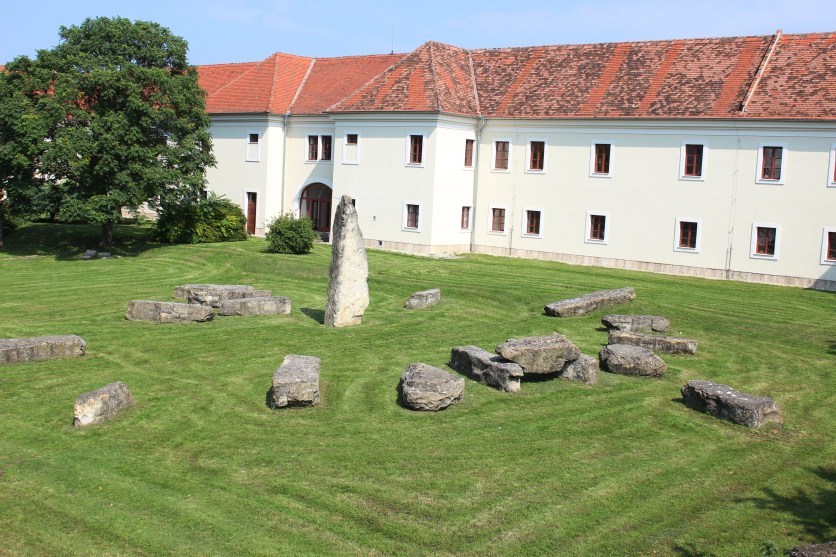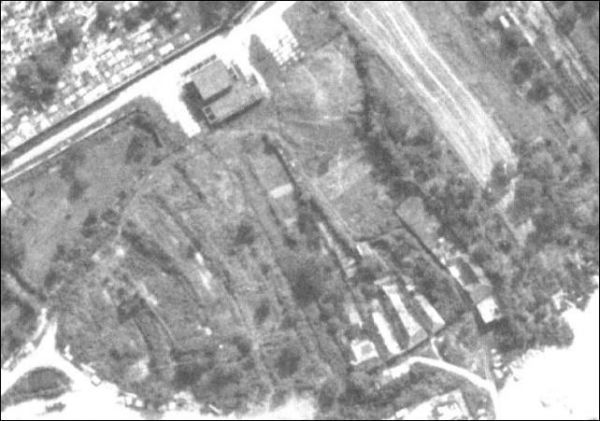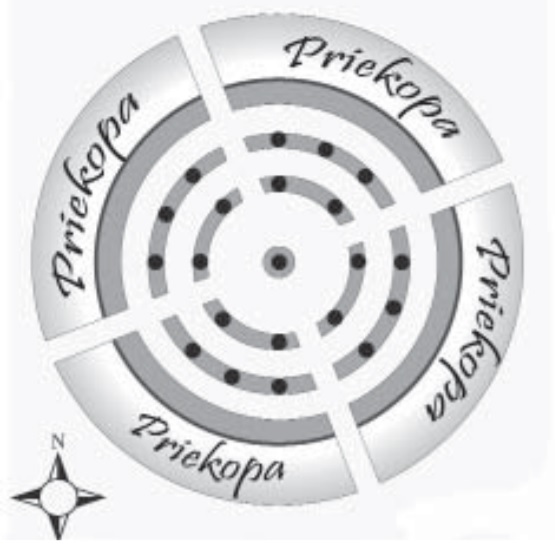Megality Holíč - Standing Stones in Slovakia

Megalit (z grečtiny mega - veľký, lithos - kameň) súhrne označuje objekty z veľkých, neopracovaných, alebo na hrubo opracovaných kameňov, budované pravekými ľuďmi. Slúžili pohrebnému, kultovému, astronomickému, prípadne chronologickému účelu. Megality sa stavali najmä v západnej a severozápadnej Európe, v Stredomorí, (vo vnútornej) Afrike, na Arabskom polostrove (Palestína), v Indii, strednej Ázii, Indonézii, Japonsku, na Veľkonočných ostrovoch a na Madagaskare. Megalitická kultúra bola rozšírená tiež v Južnej Amerike. Nešlo však o jednotnú (archeologickú) kultúru. V západnej a severozápadnej Európe (tzv. megalitická kultúra) vznikali megality najmä v eneolite a v strednej dobe bronzovej, na Sardínii napríklad aj v dobe železnej.
Ich vznik nesúvisí s jednou konkrétnou etnickou skupinou alebo kultúrou. Najznámejšia megalitická stavba na svete je Stonehenge.
Menhir znamená v bretónčine dlhý, vertikálne osadený kameň. Tieto kamene symbolizovali v predstavách rôznych kultov mŕtveho človeka. Akoby jeho duša prešla do nich. Nebolo však obvyklé pochovávať pri nich ľudí.
Len málokto vie, že aj Slovensko má svoj „Stonehenge“. Svätyňa sa nachádzala na okraji mesta Holíč na západnom Slovensku, na juhozápadnom svahu pieskovej duny.
V osemdesiatych rokoch minulého storočia sa v Holíči stavalo sídlisko. Pri hĺbení základov narazili robotníci na obrovské štvor- až šesťmetrové kamene. Na koncoch boli opracované, na niektorých sa našli aj primitívne kresby. Najvýraznejšie sú vyobrazenia nástrojov (kováčske aj poľnohospodárske nástroje), ľudská postava a vyobrazenie boha... Pozoruhodné sú pritom nielen tvary kameňov, dekorácia – symboly na nich, ale aj ich dispozícia v objekte. Z nej vyplýva, že pri stavbe svätyne sa vychádzalo z magického princípu. Ústredný idol je symbol hlavného božstva – boha hromu, ktorý má okolo seba osem kameňov a okolo nich je 12 ďalších kameňov, ktoré sú zoradené v skupinách.
Autor objavu, PhDr. Rudolf Irša, o nich napísal už niekoľko kníh. To, že ide o skutočné opracované kultové kamene (megality), potvrdil aj uznávaný francúzsky bádateľ, špecialista na megalitické pamiatky prof. Charles-Tanguy Le Roux z francúzskeho Národného centra pre vedu a výskum. Znaky na kameňoch by podľa Le Rouxa mohli zapadať do obdobia konca bronzovej a začiatku železnej doby. Holíčske megality sú pamiatkou na doteraz neznámu kultúru na Slovensku. Podľa autora objavu najvýraznejšie obrazy pochádzajú z konca neolitu a začiatku staršej bronzovej doby, na kameňoch sú však aj staršie a mladšie vyobrazenia.
Rekonštrukcia objektu narážala po dlhú dobu na ťažkosti spôsobené jeho čiastočným zničením počas výstavby sídliska a prekážkami, ktoré výskumu kládlo miestne archeologické pracovisko. Dalo súhlas k stavbe v tejto časti sídliska bez požiadavky archeologického prieskumu terénu. Po objave kameňov ich objav bagatelizovalo s tým, že nejde o archeologickú lokalitu. Po mnohých rokoch sa však objavil prameň, ktorý priniesol vysvetlenie situácie do začiatku výstavby sídliska. Tým prameňom sú letecké, resp. satelitné snímky terénu vyhotovené do roku 1988. Tie objasňujú najmä dispozíciu kameňov v tej svätyni, z ktorej sa podarilo zachrániť takmer všetky kamene a ktoré sú dnes umiestnené v lapidáriu v centre mesta za múzeom fajansy.

Pôvodné nálezisko (The original location)
Holíčska svätyňa
Na pahorku nad sídliskom SNP sa do roku 1988 nachádzala praveká kruhová svätyňa (rondel), ktorá bola tvorená dvoma priekopami. Priemer vonkajšej priekopy bol 60 m. Rondely sú v strednej Európe datované do obdobia pred 5500 az 6500 rokmi. V strednej Európe sa doposiaľ v nich nenašli kamenné objekty, v západnej Európe však najznámejšia svätyňa Stonehenge stojí uprostred rondelu. Pri výstavbe sídliska v rokoch 1988 – 2008 bol rondel a jeho svätyne zničené. Dodnes sa z nich zachovalo len 22 kameňov, ktoré sú umiestnené v tomto lapidáriu. Ostatné kamene boli pri stavbe odvezené na neznáme miesto, alebo sú zahrnuté v rámci terénnych úprav na sídlisku, časť sa nachádza ešte na pôvodnom mieste. Medzi priekopami bolo osem kamenných kruhových svätýň a jedna bola v strede. Svätyne boli umiestnené vo veľkých okrúhlych jamách a boli tvorené hrubo opracovanými kameňmi. Takmer všetky kamene uložené v lapidáriu pochádzajú z jednej svätyne zo severozápadnej časti rondelu. Kamene boli sústredené vo dvoch kruhoch, kde sa nachádzali nízke a široké „ženské“ kamene a vysoké štíhle „mužské“ kamene. V strede stál hlavný idol, v súčasnosti jediný vztýčený kameň v lapidáriu. Umiestnenie svätýň a kameňov v rámci rondelu malo astronomický a najmä magický význam.

Svatyna - predpokladaný stav (The sanctuary - predicted state)
Súčasný stav
Kamene sú umiestnené do kruhu. Dnes majú funkciu slnečných hodín. Uprostred stojí hlavný menhir - asi päť metrov vysoký kameň. Kamene sú pieskovcové, miestneho pôvodu.
Práve na centrálnom kameni si možno veľmi rýchlo všimnúť vytesané obrazce. Najvýraznejší je obrazec vyzerajúci ako kladivo alebo mlat. Podobne aj ostatné obrazce zrejme predstavujú nástroje. Kladivo je atribútom boha hromu.
Podmienky logovania:
1 - Odfoťte sa vy, alebo svoje GPS zariadenie pri menhire.
2 - Do spravy cez Messenger mi poslite názov náleziska megalitov, alebo menhiru buď vo vašej krajine alebo k vám najbližšej krajiny. V tomto tvare: názov krajiny - názov miesta - názov náleziska .
(príklad: England - Wiltshire – Stonehenge )
Prosím, neposielajte mi odpoveď typu Holíčské menhiry, alebo Stonehenge. Ďakujem.
Vašu odpoveď a fotku odosielajte spolu s Vaším Found it! logom. Ak niečo nebude v poriadku, budem Vás kontaktovať. Logy bez splnených úloh môžu byť vymazané.
 English listing English listing 
Megalith
The word "megalith" comes from the Ancient Greek "μέγας" (transl. megas meaning "great") and "λίθος" (transl. lithos meaning "stone").
Megalith collectively refers to objects from large, unprocessed or roughly cut stones, built by prehistoric people. They served as a funeral cult, and for astronomical or chronological purposes. The megaliths were built mainly in Western and Northwestern Europe, the Mediterranean, (in Africa), the Arabian Peninsula (Palestine), India, Central Asia, Indonesia, Japan, the Easter Islands and Madagascar. Megalithic culture also expanded to South America. However, it was not a unified (archaeological) culture. In western and north-western Europe (so-called megalithic culture) megaliths originated mainly in Eneolithic Period and in the Middle Bronze Age, in Sardinia, for example, during the Iron Age.
Their formation is not related to one particular ethnic group or culture. The most famous megalithic structure in the world is Stonehenge.
Menhir
A menhir (from Brittonic languages: maen or men, "stone" and hir or hîr, "long") is a large upright standing stone. In different cults, these stones symbolized the dead; as if their souls were transferred into them. It was not, however, usual to bury people near them.
Few people know that even Slovakia has its "Stonehenge". The sanctuary was situated on the outskirts of the town of Holic in western of the Slovakia, on the south-western slope of the sand dune.
In the 80s of the last century, a housing development was being built in Holic. When excavating the foundations, the workers encountered huge four to six-meter stones. The ends of the stones were processed, some of them had primitive drawings. The most significant are the paintings of tools (blacksmithing and agricultural tools), a human figure and an image of a deity ... Remarkable are the shapes of the stones, the decorations- symbols, but also their placement in the structure. It means that the construction of the sanctuary is based on a magical principle. The central idol is the symbol of the main deity - the god of thunder, with eight stones around it, and with another 12 stones in groups.
The author of discovery, PhDr. Rudolf Irsa has written several books about them. The fact that the stones are real cult stones (megaliths) was also confirmed by the acclaimed French researcher, a specialist on megalithic monuments, prof. Charles-Tanguy Le Roux of the French National Center for Science and Research. The signs on the stones, according to Le Roux, could fit into the end of the Bronze Age and the beginning of the Iron Age. Holic's megaliths are a monument of an unknown culture in Slovakia. According to the author, the most significant drawings come from the end of the Neolithic Age and the beginning of the early Bronze Age, but there are also older and younger stones. Reconstruction of the structure has been hindered for a long time by the difficulties caused by its partial destruction during the construction of the housing development and by the obstacles posed by that the local archaeological site oversight. They gave permission for construction works in this part of the development without archaeological survey. When the stones were discovered their discovery was understated by claiming it was not an archaeological site. After many years, however, a source emerged, which explained the situation in the beginning of the development construction. An aerospace and satellite imagery of the terrain made until 1988 illustrate mainly how the stones were arranged in the sanctuary from which almost all the stones were saved and which are now located in the Lapidarium in the city centre behind the Faience museum.
Holic's sanctuary
Until 1988, on the hill above the SNP housing development, there was a circular sanctuary (rondel), which was made up of two ditches. The diameter of the external ditch was 60 m. Rondels in central Europe are estimated to be between 5500 and 6500 years old. In central Europe, stone objects have not been found yet, but in Western Europe, the most famous Stonehenge sanctuary stands in the middle of a rondel. During the construction of the housing estate between 1988 and 2008, the rondel and its sanctuaries were destroyed. Until today, only 22 stones have been preserved in this Lapidarium. Other stones were taken to an unknown location during the construction or were included in the landscaping of the housing development; a part is still in the original location. There were eight circular stone sanctuaries between the ditches and one in the middle. The sanctuaries were placed in large circular pits and were made of roughly cut stones. Almost all stones deposited in the Lapidarium come from one sanctuary from the northwestern part of the rondel. The stones were centred in two circles, where there were low and wide "feminine" stones and high slender "male" stones. In the centre was the main idol, now the only one upright stone in the Lapidarum. The placement of sanctuaries and stones within the rondel has an astronomical and, above all, magical significance.
Current status
The stones are placed in a circle. Today they have a sundial function. In the centre stands the main menhir - about five meters tall. The stones are from sandstone of local origin. On the central stone, you can notice carved drawings. The most significant drawing is the one of a hammer or a flail. Also, the other shapes seem to be tools. The hammer is the attribute of the god of thunder.
Logging conditions:
1 - Take a picture of you or your GPS device at the menhir.
2 - Send me (use Messenger) the name of megaliths or menhir in your country or your nearest country. In this shape: country name - region or city name - name of the site
(example: England - Wiltshire – Stonehenge)
Please, send your response and photo together with your Found it! log. In case there will be something wrong, I will contact you. Logs without completed tasks can be deleted.
Virtual Reward - 2017/2018
This Virtual Cache is part of a limited release of Virtuals created between August 24, 2017 and August 24, 2018. Only 4,000 cache owners were given the opportunity to hide a Virtual Cache. Learn more about Virtual Rewards on the Geocaching Blog.
|